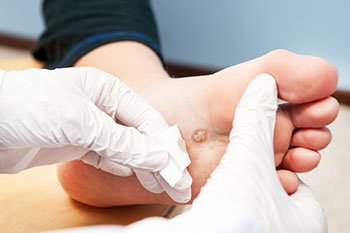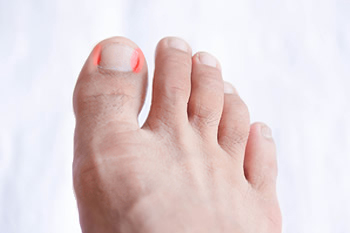Corns and warts are two similar looking skin growths that can crop up on the feet. A wart is a fleshy growth on the foot caused by a human papillomavirus (HPV) infection. The warts tend to have a rough, grainy texture, with small black dots appearing in the center. Warts can grow by themselves or in clusters. Corns, on the other hand, are thick, hard bumps that develop on the skin due to repetitive friction. Corns usually grow on the tops and sides of the feet, particularly on top of the toes, or in between the toes. They may be surrounded by dry, flaky skin. Both corns and warts can be painful, especially if pressure is applied to them while standing or walking. Whether you have warts or corns, don’t hesitate to schedule an appointment with a podiatrist, who can diagnose your condition and prescribe the right treatment for you.
Corns can make walking very painful and should be treated immediately. If you have questions regarding your feet and ankles, contact Bruce Smit, DPM of Frankfort Foot & Ankle Clinic. Our doctor will treat your foot and ankle needs.
Corns: What Are They? And How Do You Get Rid of Them?
Corns are thickened areas on the skin that can become painful. They are caused by excessive pressure and friction on the skin. Corns press into the deeper layers of the skin and are usually round in shape.
Ways to Prevent Corns
There are many ways to get rid of painful corns such as:
Treating Corns
Although most corns slowly disappear when the friction or pressure stops, this isn’t always the case. Consult with your podiatrist to determine the best treatment option for your case of corns.
If you have any questions please feel free to contact our office located in Frankfort, IL . We offer the newest diagnostic and treatment technologies for all your foot and ankle needs.
 There are many reasons why the side of your foot may be in pain. Often, seemingly minor injuries, like a stress fracture in one of the bones of the foot or ankle, can produce pain on the side of the foot. Ankle sprains, cuboid syndrome, and peroneal tendonitis can occur due to damage to the ligaments, bones, or tendons of the feet and ankles, respectively. Deformities and skin conditions, such as bunions, corns, and calluses may also be to blame. A congenital condition called tarsal coalition can result in foot pain, fatigue, flat feet, and a dysfunctional gait. Arthritis, both rheumatoid and osteoarthritis, is also a potential cause of foot pain. If you have pain on the side of your foot, don’t wait for it to go away on its own, as untreated pain can often become chronic. Instead, seek the care of a podiatrist, who can diagnose and treat your condition.
There are many reasons why the side of your foot may be in pain. Often, seemingly minor injuries, like a stress fracture in one of the bones of the foot or ankle, can produce pain on the side of the foot. Ankle sprains, cuboid syndrome, and peroneal tendonitis can occur due to damage to the ligaments, bones, or tendons of the feet and ankles, respectively. Deformities and skin conditions, such as bunions, corns, and calluses may also be to blame. A congenital condition called tarsal coalition can result in foot pain, fatigue, flat feet, and a dysfunctional gait. Arthritis, both rheumatoid and osteoarthritis, is also a potential cause of foot pain. If you have pain on the side of your foot, don’t wait for it to go away on its own, as untreated pain can often become chronic. Instead, seek the care of a podiatrist, who can diagnose and treat your condition.
Foot Pain
Foot pain can be extremely painful and debilitating. If you have a foot pain, consult with Bruce Smit, DPM from Frankfort Foot & Ankle Clinic. Our doctor will assess your condition and provide you with quality foot and ankle treatment.
Causes
Foot pain is a very broad condition that could be caused by one or more ailments. The most common include:
Diagnosis
To figure out the cause of foot pain, podiatrists utilize several different methods. This can range from simple visual inspections and sensation tests to X-rays and MRI scans. Prior medical history, family medical history, and any recent physical traumatic events will all be taken into consideration for a proper diagnosis.
Treatment
Treatment depends upon the cause of the foot pain. Whether it is resting, staying off the foot, or having surgery; podiatrists have a number of treatment options available for foot pain.
If you have any questions, please feel free to contact our office located in Frankfort, IL . We offer the newest diagnostic and treatment technologies for all your foot care needs.
 Bunions are bony growths that appear on the outer side of the foot at the base of the big toe joint. This is a deformity that may cause pain, swelling, redness, and difficulty wearing shoes and while walking. When left untreated, bunions tend to progressively worsen over time. As a bunion grows, it pushes the big toe towards the smaller toes, changing the shape of the foot in the process. The misaligned big toe may then push the second toe out of alignment. Bunions can also lead to arthritis in the big toe joints. Bunions can be managed and their progression can be slowed through a variety of conservative treatments, such as footwear modifications. Surgery may also be an option and can permanently correct a bunion. If you suffer from bunions, it is suggested that you see a podiatrist for treatment.
Bunions are bony growths that appear on the outer side of the foot at the base of the big toe joint. This is a deformity that may cause pain, swelling, redness, and difficulty wearing shoes and while walking. When left untreated, bunions tend to progressively worsen over time. As a bunion grows, it pushes the big toe towards the smaller toes, changing the shape of the foot in the process. The misaligned big toe may then push the second toe out of alignment. Bunions can also lead to arthritis in the big toe joints. Bunions can be managed and their progression can be slowed through a variety of conservative treatments, such as footwear modifications. Surgery may also be an option and can permanently correct a bunion. If you suffer from bunions, it is suggested that you see a podiatrist for treatment.
If you are suffering from bunions, contact Bruce Smit, DPM of Frankfort Foot & Ankle Clinic. Our doctor can provide the care you need to keep you pain-free and on your feet.
What Is a Bunion?
A bunion is formed of swollen tissue or an enlargement of boney growth, usually located at the base joint of the toe that connects to the foot. The swelling occurs due to the bones in the big toe shifting inward, which impacts the other toes of the foot. This causes the area around the base of the big toe to become inflamed and painful.
Why Do Bunions Form?
Genetics – Susceptibility to bunions are often hereditary
Stress on the feet – Poorly fitted and uncomfortable footwear that places stress on feet, such as heels, can worsen existing bunions
How Are Bunions Diagnosed?
Doctors often perform two tests – blood tests and x-rays – when trying to diagnose bunions, especially in the early stages of development. Blood tests help determine if the foot pain is being caused by something else, such as arthritis, while x-rays provide a clear picture of your bone structure to your doctor.
How Are Bunions Treated?
If you have any questions, please feel free to contact our office located in Frankfort, IL . We offer the newest diagnostic and treatment technologies for all your foot care needs.
 Plantar warts are benign skin growths that occur on the soles of the feet due to a human papillomavirus (HPV) infection. HPV can get into the feet through a tiny crack in the skin and make the top layer of skin grow rapidly, thereby creating a wart. Warts on the bottom of the feet may be asymptomatic, or they may cause pain or discomfort while standing or walking due to pressure on the bottom of the foot. Plantar warts can typically be diagnosed through a physical examination and can be treated through medications, cryotherapy, or surgical removal. If you have plantar warts, consult with a podiatrist to find the right treatment for you.
Plantar warts are benign skin growths that occur on the soles of the feet due to a human papillomavirus (HPV) infection. HPV can get into the feet through a tiny crack in the skin and make the top layer of skin grow rapidly, thereby creating a wart. Warts on the bottom of the feet may be asymptomatic, or they may cause pain or discomfort while standing or walking due to pressure on the bottom of the foot. Plantar warts can typically be diagnosed through a physical examination and can be treated through medications, cryotherapy, or surgical removal. If you have plantar warts, consult with a podiatrist to find the right treatment for you.
Plantar warts can be very uncomfortable. If you need your feet checked, contact Bruce Smit, DPM from Frankfort Foot & Ankle Clinic. Our doctor will assist you with all of your foot and ankle needs.
About Plantar Warts
Plantar warts are the result of HPV, or human papillomavirus, getting into open wounds on the feet. They are mostly found on the heels or balls of the feet.
While plantar warts are generally harmless, those experiencing excessive pain or those suffering from diabetes or a compromised immune system require immediate medical care. Plantar warts are easily diagnosed, usually through scraping off a bit of rough skin or by getting a biopsy.
Symptoms
Treatment
To help prevent developing plantar warts, avoid walking barefoot over abrasive surfaces that can cause cuts or wounds for HPV to get into. Avoiding direct contact with other warts, as well as not picking or rubbing existing warts, can help prevent the further spread of plantar warts. However, if you think you have developed plantar warts, speak to your podiatrist. He or she can diagnose the warts on your feet and recommend the appropriate treatment options.
If you have any questions please feel free to contact our office located in Frankfort, IL . We offer the newest diagnostic and treatment technologies for all your foot and ankle needs.
 A broken or fractured ankle is a potentially painful injury that can range in severity from a mild avulsion fracture to a severe break of the tibia, fibula, or both. The symptoms of a broken ankle may include pain at the site of the fracture, significant swelling, bruising, ankle deformity, and an inability to walk. In the case of an open fracture, the broken bone may even protrude from the skin. Broken ankles require a diagnosis and medical treatment. Your podiatrist will be able to diagnose a fracture through a combination of physical examination and imaging studies like X-rays, bone scans, or MRIs. If you suspect that you may have broken your ankle, please seek the care of a podiatrist.
A broken or fractured ankle is a potentially painful injury that can range in severity from a mild avulsion fracture to a severe break of the tibia, fibula, or both. The symptoms of a broken ankle may include pain at the site of the fracture, significant swelling, bruising, ankle deformity, and an inability to walk. In the case of an open fracture, the broken bone may even protrude from the skin. Broken ankles require a diagnosis and medical treatment. Your podiatrist will be able to diagnose a fracture through a combination of physical examination and imaging studies like X-rays, bone scans, or MRIs. If you suspect that you may have broken your ankle, please seek the care of a podiatrist.
Broken ankles need immediate treatment. If you are seeking treatment, contact Bruce Smit, DPM from Frankfort Foot & Ankle Clinic. Our doctor can provide the care you need to keep you pain-free and on your feet.
Broken Ankles
A broken ankle is experienced when a person fractures their tibia or fibula in the lower leg and ankle area. Both of these bones are attached at the bottom of the leg and combine to form what we know to be our ankle.
When a physician is referring to a break of the ankle, he or she is usually referring to a break in the area where the tibia and fibula are joined to create our ankle joint. Ankles are more prone to fractures because the ankle is an area that suffers a lot of pressure and stress. There are some obvious signs when a person experiences a fractured ankle, and the following symptoms may be present.
Symptoms of a Fractured Ankle
If you suspect an ankle fracture, it is recommended to seek treatment as soon as possible. The sooner you have your podiatrist diagnose the fracture, the quicker you’ll be on the way towards recovery.
If you have any questions, please feel free to contact our office located in Frankfort, IL . We offer the newest diagnostic and treatment technologies for all your foot care needs.
Striking a good balance between standing, sitting, and moving around throughout the day is optimal for the human body. But what do you do if your job requires you to stand most of the time? Prolonged standing (standing for more than 8 hours) puts an abundance of pressure on your feet, joints and back, and can cause ongoing circulation problems in the feet and legs (chronic venous insufficiency) with symptoms such as swelling (edema), varicose veins, and even leg ulcers should the condition progress. To help ease the burden you put on your body by working on your feet all day, try to sit as much as possible during breaks, move around whenever you can and change standing positions frequently to shift body weight around. You should also try to soften your knees, use a wide stance to balance your weight evenly, engage your core whenever possible to relieve stress on your feet and knees, and stand on a cushioned mat if possible. Above all else, wear good shoes that fit well, offer proper heel and arch support, and have a sole that’s wider than the heel. If you contact a podiatrist, they can offer additional advice on proper footwear, create custom orthotics to support your particular foot and ankle structure all day, and address issues you may be experiencing in those areas.
While working on the feet, it is important to take the proper care of them. For more information about working on your feet, contact Bruce Smit, DPM from Frankfort Foot & Ankle Clinic. Our doctor will treat your foot and ankle needs.
Working on Your Feet
Standing on your feet for long periods of time can cause stress and pain in your feet. Your whole body may experience change in terms of posture, back pain, bunions, callouses and or plantar warts. There are ways to avoid these conditions with proper foot care, smart choices and correct posture.
Positive Changes
Negative heeled shoe – Choosing this shoe type places the heel slightly lower than the ball of the foot. These are great for overall foot health. Find shoes that fit you correctly.
Go barefoot – Our feet were not designed to be enclosed for all hours of the day. Try to periodically expose your feet to air.
Eliminate Pain
Foot Exercises – Performing simple exercises, incorporating yoga and doing stretches are beneficial. This will allow increased blood flow to the area and muscles of the foot.
Achilles tendon – Stretching the foot out flat on the floor will relax the calf muscles and tendon. These exercises can be performed almost anywhere. Make sure you add these exercises to your daily regimen.
With a little bit of this information and knowing more about foot health, you will notice changes. Foot stretches and proper footwear will help with pain and prevent further issues.
If you have any questions please feel free to contact our office located in Frankfort, IL . We offer the newest diagnostic and treatment technologies for all your foot and ankle needs.
 An ingrown toenail occurs when the toenail curves and grows down into the skin on the sides of the nail. As the toenail digs into the flesh and the flesh grows around it, pain, inflammation, redness, swelling or even an infection can follow. Common factors that lead to ingrown toenails include genetics (such as poor posture, gait, or a deformity), improperly cutting the toenails, and wearing tight shoes. Ingrown toenails are not usually serious. However, they can become very painful and infected if left untreated. If you have diabetes or a compromised immune system, your nail is in persistent pain, or your nail is showing signs of being infected, you should consult with a podiatrist for a proper treatment option.
An ingrown toenail occurs when the toenail curves and grows down into the skin on the sides of the nail. As the toenail digs into the flesh and the flesh grows around it, pain, inflammation, redness, swelling or even an infection can follow. Common factors that lead to ingrown toenails include genetics (such as poor posture, gait, or a deformity), improperly cutting the toenails, and wearing tight shoes. Ingrown toenails are not usually serious. However, they can become very painful and infected if left untreated. If you have diabetes or a compromised immune system, your nail is in persistent pain, or your nail is showing signs of being infected, you should consult with a podiatrist for a proper treatment option.
Ingrown toenails may initially present themselves as a minor discomfort, but they may progress into an infection in the skin without proper treatment. For more information about ingrown toenails, contact Bruce Smit, DPM of Frankfort Foot & Ankle Clinic. Our doctor can provide the care you need to keep you pain-free and on your feet.
Ingrown Toenails
Ingrown toenails are caused when the corner or side of a toenail grows into the soft flesh surrounding it. They often result in redness, swelling, pain, and in some cases, infection. This condition typically affects the big toe and may recur if it is not treated properly.
Causes
You are more likely to develop an ingrown toenail if you are obese, have diabetes, arthritis, or have any fungal infection in your nails. Additionally, people who have foot or toe deformities are at a higher risk of developing an ingrown toenail.
Symptoms
Some symptoms of ingrown toenails are redness, swelling, and pain. In rare cases, there may be a yellowish drainage coming from the nail.
Treatment
Ignoring an ingrown toenail can have serious complications. Infections of the nail border can progress to a deeper soft-tissue infection, which can then turn into a bone infection. You should always speak with your podiatrist if you suspect you have an ingrown toenail, especially if you have diabetes or poor circulation.
If you have any questions, please feel free to contact our office located in Frankfort, IL . We offer the newest diagnostic and treatment technologies for all your foot care needs.
Extracorporeal Shock Wave Therapy (ESWT) is a non-invasive treatment that pulses high-energy sound waves through a hand-held device onto the site of pain, which permeate into underlying damaged tissue to reduce pain, stimulate tissue growth, and accelerate the healing process. ESWT has been used to treat foot and ankle conditions such as plantar fasciitis, Achilles tendonitis, and more. Since ESWT is a treatment that is administered outside of the body (extra corporeally), it is an alternative to surgery which may offer pain relief and faster healing along with a shorter recovery time. Individuals who are pregnant, have a pacemaker, take certain medications, or have medical conditions such as neuropathy are not good candidates for ESWT. If you have chronic pain in your foot or ankle that has not responded to other treatments, it is suggested you contact a podiatrist who will perform an examination and determine if ESWT is an option for you.
Shockwave therapy is a treatment commonly used to treat various injuries and conditions, particularly plantar fasciitis in the feet. To learn more, consult with Bruce Smit, DPM from Frankfort Foot & Ankle Clinic. Our doctor can provide the care you need to keep you pain-free and on your feet.
Shockwave Therapy
Shockwave therapy is a new treatment option designed to treat bone conditions such as tennis elbow, shoulder pain, and others. Shockwave therapy uses high intensity sound waves that are directed to the affected tissues of the body with pinpoint accuracy. The effects are very beneficial, leading to a production of collagen fibers, eliminating inflammation.
Who Benefits from Shockwave?
Shockwave is recommended for patients suffering from heel pain and associated problems. Heel pain is a common condition which can be caused by obesity, overexertion, and spending a substantial amount of time on hard floors with your feet exposed and unsupported.
Fast and Easy
The therapy is actually a simple process that can leave patients feeling better the very next day. Shockwave therapy is not as dramatic as it sounds. It enables more blood flow to effected areas, addressing the source of the problem and allowing treatment to last for a long time.
Treatment & Recovery Time
Shockwave treatment will enable your feet to recover quickly. This is especially important since surgery is not required. It is cost effective and does not require the use of anesthesia. This treatment is a better option to surgery, since it is proven safe.
If you have any questions, please feel free to contact our office located in Frankfort, IL . We offer the newest diagnostic and treatment technologies for all your foot and ankle needs.